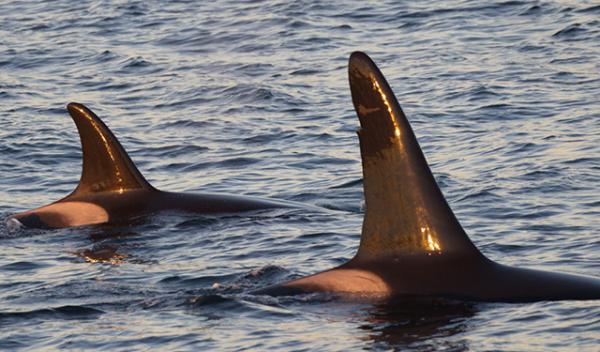KID REPORTERS’ NOTEBOOK
Killer Whales on the Loose

WATCH THE VIDEO
Click below to see Ben’s interview with marine biologist Alisa Schulman-Janiger.
Killers are on the loose. Killer whales, that is. This winter, whale watchers have been treated to rare sightings of a pod of more 50 killer whales off the coast of Southern California. Marine biologist and whale expert Alisa Schulman-Janiger described these whales as “shark specialists” who hunt and eat mainly sharks and opah.
“It’s really exciting because we don’t see them every year,” Schulman-Janiger said in a recent interview. Following the pod allows scientists to learn more about these mysterious creatures.

Scoopfin (named for the scoop in his dorsal fin) returns to Southern California this year.
Schulman-Janiger is part of the California Killer Whale Project, a team of two scientists who track killer whale sightings. She identified the newcomers as “offshore” killer whales. They differ from “transient” killer whales seen regularly passing through the waters of Southern California.
Transient killer whales have pointy dorsal fins, live in small family groups, and eat a variety of marine mammals, including seals, sea lions, dolphins, and whales. Offshore killer whales have dorsal fins with rounded tips and often travel in groups of 40 or more.
Schulman-Janiger was particularly excited to recognize a 25-foot male whom she first saw in 1995. She had nicknamed Scoopfin because of the distinct scoop in his dorsal fin.
“He’s curious,” the marine biologist observed, “because he approached the boat and turned on his side looking at people.”
A WORRY FOR SHARKS
What brings these offshore killer whales closer to the coast? Schulman-Janiger believes that they are foraging for sharks.
“It could be that one year they found a bunch of sharks and decided to come back down because it was a good place to feed,” she said. “It’s all about the food.”
Asked if humans should fear killer whales, Schulman-Janiger said, “Never, ever, ever, ever in the wild.”
The marine biologist has been three feet from a killer whale in the water, when he approached the GoPro she held over the side of a boat. “I’m not saying that people should jump in the water with them,” she added. “But I would never be worried.”
In fact, Schulman-Janiger welcomes any chance to get close to killer whales. “Every time we see them,” she said, “we get more information about them and learn about their lives.”
Photo of Scoopfin courtesy of of Alisa Schulman-Janiger
